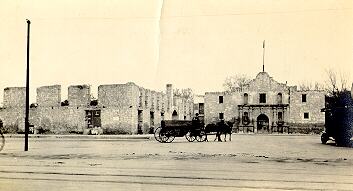urged the attack to move more rapidly and to close for final assault on the defenses. The raging, bloody battle that followed was over by eight o'clock in the morning, and all of the 182 Alamo defenders perished in the fight, but at a staggering loss to the assault forces. The last to resist were those who held out in the old mission church, now the Alamo Shrine.
As a result of the battle, the buildings and walls of the Alamo complex had suffered considerable damage. When the Mexican Army moved out of San Antonio, General Vicente Filisola, second in command under Santa Anna, sent orders to General Andrade to demolish the Alamo's fortifications and spike the guns, "rendering them useless for all times," then to proceed to join the main army at Goliad (Fox, Bass, and Hester, 1976:12). This was carried out by the soldiers to the best of their abilities during May 22-24, 1836, by leveling all single walls, tearing up and burning the wood palisades, and filling all open trenches. The section of palisade trench found during the archaeological excavations had been backfilled at this time. Some of the main structures, including the old church, had been built much too sturdily to be easily destroyed and therefore were left standing. Although an attempt was made to burn the church by setting fire to the wood artillery ramp and platform on the inside, little additional damage was actually done.
Following the departure of the Mexican troops, the Alamo lay vacant and unclaimed for several years. Then, on January 13, 1841, by an Act of the Congress of the Republic of Texas, it was declared that the Alamo property would belong to the Roman Catholic Church (ibid.).
The United States Army took an interest in the Alamo ruins when Texas was annexed to the United States in 1845 and involvement in the Mexican War in 1846 created a need for more military installations in the borderlands. Because of its location and commerce, San Antonio was selected as headquarters for the Eighth Military District. On January 2, 1849, Major E. B. Babbitt, acting Quartermaster, took possession of the remaining Alamo buildings, which the army leased from the Catholic Church. The buildings were repaired at considerable expense to serve as a U.S. Army Quartermaster Depot, which would freight supplies from the port of Indianola through the Alamo depot and on to other Army posts (Corner, 1890:10). It was during the Army repairs to the buildings that the curvilinear gable was constructed on top of the old church, along with installing upper flooring, windows, and a new roof (Smith, 1967:25). With the Anmy occupation, houses and commercial enterprises began to line Alamo Plaza, and Menger opened his hotel next to the Alamo Depot in 1859.
Shortly after commencement of the Civil War in 1861, the Alamo was seized by secessionists and became a Confederate Army depot. During this time the old church caught fire, and the entire interior, including the wooden roof, burned; the building had to again be completely repaired.

The Alamo buildings that were not used by the Army were essentially
left unoccupied until 1877, when Honore Grenet bought the old Long Barracks
and its courtyard from